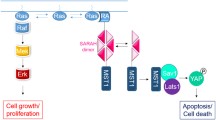Abstract
Fluorescence resonance energy transfer (FRET) from a donor-labelled molecule to an acceptor-labelled molecule is a useful, proximity-based fluorescence tool to discriminate molecular states on the surface and in the interior of cells. Most microscope-based determinations of FRET yield only a single value, the interpretation of which is necessarily model-dependent. In this paper we demonstrate two new measurements of FRET heterogeneity using selective donor photobleaching in combination with synchronous donor/acceptor detection based on either (1) full kinetic analysis of donor-detected and acceptor-detected donor photobleaching or (2) a simple time-based ratiometric approach. We apply the new methods to study the cell surface distribution of concanavalin A yielding estimates of FRET and non-FRET population distributions, as well as FRET efficiencies within the FRET populations.




Similar content being viewed by others
References
Bastiaens PIH, Jovin TM (1996) Microscopic imaging tracks the intracellular processing of a signal transduction protein: fluorescent-labeled protein kinase C βI. Proc Natl Acad Sci USA 93:8407–8412
Bastiaens PIH, Majoul IV, Verveer PJ, Soling HD, Jovin TM (1996) Imaging the intracellular trafficking and state of the AB5 quaternary structure of cholera toxin. EMBO J 15:4246–4253
Berney C, Danuser G (2003) FRET or no FRET: a quantitative comparison. Biophys J 84:3992–4010
Chan SS, Arndt-Jovin D, Jovin TM (1979) Proximity of lectin receptors on the cell surface measured by fluorescence energy transfer in a flow system. J Histochem Cytochem 27:56–64
Clegg RM, Murchie AI, Zechel A, Lilley DM (1993) Observing the helical geometry of double-stranded DNA in solution by fluorescence resonance energy transfer. Proc Natl Acad Sci USA 90:2994–2998
Cohen-Kashi M, Moshikov S, Zurgil N, Deutsch M (2002) Fluorescence resonance energy transfers measurements on cell surfaces via fluorescence polarization. Biophys J 83:1395–1402
dos Remedios CG, Moens PD (1995) Fluorescence resonance energy transfer spectroscopy is a reliable “ruler” for measuring structural changes in proteins: dispelling the problem of the unknown orientation factor. J Struct Biol 115:175–185
Feller M, Richardson C, Behnke WD, Gruenstein E (1977) High and low affinity binding sites for concanavalin A on normal human fibroblasts in vitro. Biochem Biophys Res Commun 76(4):1027–1035
Fernandez SM, Berlin RD (1976) Cell surface distribution of lectin receptors determined by resonance energy transfer. Nature 264:411–415
Gadella TW Jr, Jovin TM (1995) Oligomerization of epidermal growth factor receptors on A431 cells studied by time-resolved fluorescence imaging microscopy: a stereochemical model for tyrosine kinase receptor activation. J Cell Biol 129:1543–1558
Gordon GW, Berry G, Liang XH, Levine B, Herman B (1998) Quantitative fluorescence resonance energy transfer measurements using fluorescence microscopy. Biophys J 74:2702–2713
Hirschfeld T (1976) Quantum efficiency independence of the time-integrated emission from a fluorescent molecule. Appl Opt 15:3135–3139
Hoppe A, Christensen K, Swanson JA (2002) Fluorescence resonance energy transfer-based stoichiometry in living cells. Biophys J 83:3652–3664
Jares-Erijman EA, Jovin TM (2003) FRET imaging. Nat Biotechnol 21:1387–1395
Jovin TM (2003) Quantum dots finally come of age. Nat Biotechnol 21:32–33
Jovin TM, Arndt-Jovin DJ (1989) FRET microscopy: digital imaging of fluorescence resonance energy transfer. Application in cell biology. In: Kohen E, Hirschberg JG, Ploem JS (eds) Cell structure and function by microspectrofluorometry. Academic Press, London, pp 99–117
Kenworthy AK, Edidin M (1998) Distribution of a glycosylphosphatidylinositol-anchored protein at the apical surface of MDCK cells examined at a resolution of <100 Å using imaging fluorescence resonance energy transfer. J Cell Biol 142:69–84
Klostermeier D, Millar DP (2001–2002) Time-resolved fluorescence resonance energy transfer: a versatile tool for the analysis of nucleic acids. Biopolymers 61:159–179
Kubitscheck U, Schweitzer-Steiner R, Arndt-Jovin DJ, Jovin TM, Pecht I (1993) Distribution of type I Fcε-receptors on the surface of mast cells probed by fluorescence resonance energy transfer. Biophys J 64:110–120
Mekler VM, Averbakh AZ, Sudarikov A, Kharitonova OV (1997) Fluorescence energy transfer-sensitized photobleaching of a fluorescent label as a tool to study donor-acceptor distance distributions and dynamics in protein assemblies: studies of a complex of biotinylated IrM with streptavidin and aggregates of concanavalin A. J Photochem Photobiol B Biol 40:278–287
Millar DP (2000) Time-resolved fluorescence methods for analysis of DNA-protein interactions. Methods Enzymol 323:442–459
Selvin PR (2000) The renaissance of fluorescence resonance energy transfer. Nat Struct Biol 7:730–734
St. Pierre PR, Petersen NO (1990) Relative ligand binding to small or large aggregates measured by scanning correlation spectroscopy. Biophys J 58:503–511
Stryer L, Haugland RP (1967) Energy transfer: a spectroscopic ruler. Proc Natl Acad Sci USA 58:719–726
Sykes JA, Moore EB (1959) A new chamber for tissue culture. Proc Soc Exp Biol Med 100:121–127
Szollosi J, Tron S, Damjanovich S, Helliwell SH, Arndt-Jovin D, Jovin TM (1984) Fluorescence energy transfer measurements on cell surfaces: a critical comparison of steady-state fluorometric and flow cytometric methods. Cytometry 5:210–216
Szollosi J, Nagy P, Sebestyen Z, Damjanovich S, Park JW, Matyus L (2002) Applications of fluorescence resonance energy transfer for mapping biological membranes. Rev Mol Biotechnol 82:251–266
Wallach DF, Schmidt-Ullrich R (1976) Low- and high-affinity concanavalin A binding to thymocyte plasma membrane vesicles. J Cell Physiol 89(4):771–774
Whitehead RH, Macrae FA, St John DJ, Ma J (1985) A colon cancer cell line (LIM1215) derived from a patient with inherited nonpolyposis colorectal cancer. J Natl Cancer Inst 74:759–765
Young RM, Arnette JK, Roess DA, BG Barisas (1994) Quantitation of fluorescence resonance energy transfer between cell surface proteins via fluorescence donor photobleaching kinetics. Biophys J 67:881–888
Author information
Authors and Affiliations
Corresponding author
Rights and permissions
About this article
Cite this article
Clayton, A.H.A., Klonis, N., Cody, S.H. et al. Dual-channel photobleaching FRET microscopy for improved resolution of protein association states in living cells. Eur Biophys J 34, 82–90 (2005). https://doi.org/10.1007/s00249-004-0427-y
Received:
Revised:
Accepted:
Published:
Issue Date:
DOI: https://doi.org/10.1007/s00249-004-0427-y




